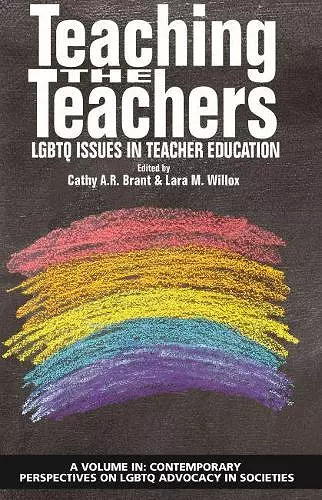Teaching the Teachers
LGBTQ Issues in Teacher Education
Cathy AR Brant editor Lara M Willox editor
Format:Paperback
Publisher:Emerald Publishing Inc
Published:6th Feb '20
Should be back in stock very soon

Teacher educators have opportunities to include issues of multicultural education, equity, and social justice in the work done with preservice teachers. Including the educational and societal experiences of historically marginalized populations in curriculum creates spaces for teacher educators to model multicultural and social justice based pedagogies, while preparing teachers to work with and work for these students. The most effective way for teacher educators to address the unique perspectives of historically and currently marginalized populations is to integrate various perspectives throughout the curriculum (Grant & Zwier, 2012). Most teacher education programs address diverse populations via an integrated approach. In fact, Sherwin and Jennings (2006) found that potential student experiences regarding social class, race, and special needs populations were typically integrated into the curriculum, however, lesbian, gay bisexual, and transgender (LGBT) issues were not. There is research that demonstrates how carefully planned and implemented educational interventions can have a positive effect on preservice teachers’ knowledge of and attitudes toward gays and lesbians (Butler, 1999). Despite the positive impact of addressing LGBTQ issues as a part of the teacher preparation program, Gorski et al. (2013) found that LGBTQ issues receive significantly less class time than other issues, especially race, and are, in fact, eight times more likely to actually be omitted from multicultural teacher educator courses. The inclusion of LGBT topics is important for a myriad of reasons. Most importantly, studies (GLSEN & Harris Interactive, 2012; Kosciw, Greytak, Diaz, Bartkiewicz, 2010, 2012; Kosciw, Greytak, Palmer, Boesen, 2014; Kosciw, Greytak, Giga, & Danischewski, 2016) have revealed a negative school climate for students who identify as gay, lesbian, bisexual, or transgender; this hostile environment can have dire consequences for these students. The impact of bullying and harassment due to LGBTQ students’ gender and/or sexual identities can produce a number of negative effects, including isolation from friends and family, depression, drug and/or alcohol use and addiction, low selfesteem, lack of engagement in school, academic failure, and fighting (Beam, 2007; Holmes & Cahill, 2004; Kosciw et al., 2010, 2012; Kosciw et al, 2014; Kosciw et al, 2016, Meyer, 2010; Wilkinson & Pearson, 2009). The negative climate does not just come from peer-to-peer negative interactions. In the most recent GLSEN study (Kosciw et al, 2016) it was found that • 57.6% of...
ISBN: 9781641138307
Dimensions: 234mm x 156mm x 10mm
Weight: 259g
178 pages